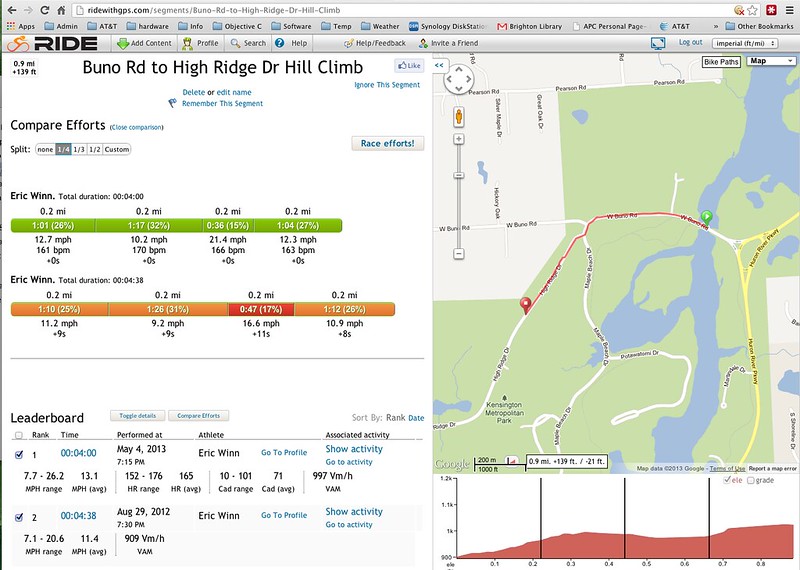Eric Winn
Zen MBB Master
This blew me away. I rode my little short 13 mile loop around Kent Lake that includes about a mile of hill climbing with some stretches purportedly in excess of an 8% grade.
A big chunk of this ride is along park MUPs so I decided to try and ride slow and concentrate on slow speed handling and to be a nicer neighbor to the other MUP users. Fortunately it was kind of cool out so I didn't have to dodge too many people...
I hit the hill section and just wanted to hold a steady pace which I tried to do. I was NOT trying to go fast.
I never felt the need to switch out of my big front ring (53x39 double) although I was weaving a little so I was prepared to do so but I just never got to the point where I wanted or needed to downshift the front ring. I was mostly in my 36T rear cog but at times popped back to my 32T or 28T.
Anyway, it felt like I was smoother but I was expecting a little better result than my 2 or 3 times doing this on the Quest but still not better than my best DF time.
Well I was shocked to see I knocked 38 seconds off my best ever time which had been on my DF after riding almost daily for most of last summer.
This was my 8th ride on my new Vendetta, bringing me to 58.54 miles on it so far.
Take a look. I didn't have my HR monitor back in Aug of last year but on the two or three runs of this route on the Quest I was generally more than 10 beats higher than today's top run figures. My fastest Quest time was 5:14 or 1 minute and 14 seconds slower than the Vendetta.
Vendetta more speed, less effort - ooohrah!
Complete RWGPS ride data.

-Eric
A big chunk of this ride is along park MUPs so I decided to try and ride slow and concentrate on slow speed handling and to be a nicer neighbor to the other MUP users. Fortunately it was kind of cool out so I didn't have to dodge too many people...
I hit the hill section and just wanted to hold a steady pace which I tried to do. I was NOT trying to go fast.
I never felt the need to switch out of my big front ring (53x39 double) although I was weaving a little so I was prepared to do so but I just never got to the point where I wanted or needed to downshift the front ring. I was mostly in my 36T rear cog but at times popped back to my 32T or 28T.
Anyway, it felt like I was smoother but I was expecting a little better result than my 2 or 3 times doing this on the Quest but still not better than my best DF time.
Well I was shocked to see I knocked 38 seconds off my best ever time which had been on my DF after riding almost daily for most of last summer.
This was my 8th ride on my new Vendetta, bringing me to 58.54 miles on it so far.
Take a look. I didn't have my HR monitor back in Aug of last year but on the two or three runs of this route on the Quest I was generally more than 10 beats higher than today's top run figures. My fastest Quest time was 5:14 or 1 minute and 14 seconds slower than the Vendetta.
Vendetta more speed, less effort - ooohrah!
Complete RWGPS ride data.

-Eric


